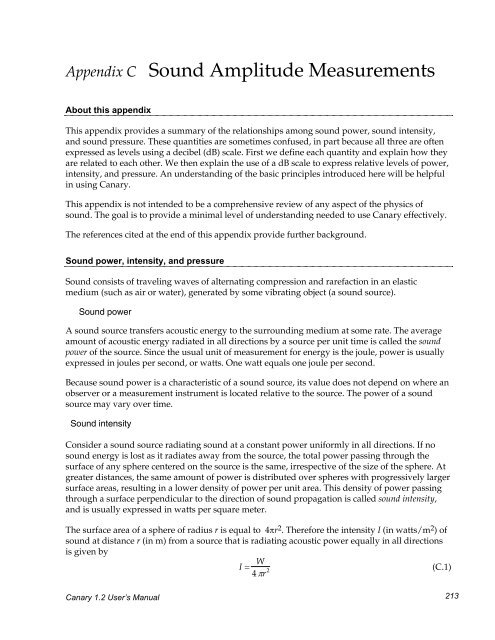User's Manual - Cornell Lab of Ornithology - Cornell University
User's Manual - Cornell Lab of Ornithology - Cornell University
User's Manual - Cornell Lab of Ornithology - Cornell University
You also want an ePaper? Increase the reach of your titles
YUMPU automatically turns print PDFs into web optimized ePapers that Google loves.
Appendix C Sound Amplitude MeasurementsAbout this appendixThis appendix provides a summary <strong>of</strong> the relationships among sound power, sound intensity,and sound pressure. These quantities are sometimes confused, in part because all three are <strong>of</strong>tenexpressed as levels using a decibel (dB) scale. First we define each quantity and explain how theyare related to each other. We then explain the use <strong>of</strong> a dB scale to express relative levels <strong>of</strong> power,intensity, and pressure. An understanding <strong>of</strong> the basic principles introduced here will be helpfulin using Canary.This appendix is not intended to be a comprehensive review <strong>of</strong> any aspect <strong>of</strong> the physics <strong>of</strong>sound. The goal is to provide a minimal level <strong>of</strong> understanding needed to use Canary effectively.The references cited at the end <strong>of</strong> this appendix provide further background.Sound power, intensity, and pressureSound consists <strong>of</strong> traveling waves <strong>of</strong> alternating compression and rarefaction in an elasticmedium (such as air or water), generated by some vibrating object (a sound source).Sound powerA sound source transfers acoustic energy to the surrounding medium at some rate. The averageamount <strong>of</strong> acoustic energy radiated in all directions by a source per unit time is called the soundpower <strong>of</strong> the source. Since the usual unit <strong>of</strong> measurement for energy is the joule, power is usuallyexpressed in joules per second, or watts. One watt equals one joule per second.Because sound power is a characteristic <strong>of</strong> a sound source, its value does not depend on where anobserver or a measurement instrument is located relative to the source. The power <strong>of</strong> a soundsource may vary over time.Sound intensityConsider a sound source radiating sound at a constant power uniformly in all directions. If nosound energy is lost as it radiates away from the source, the total power passing through thesurface <strong>of</strong> any sphere centered on the source is the same, irrespective <strong>of</strong> the size <strong>of</strong> the sphere. Atgreater distances, the same amount <strong>of</strong> power is distributed over spheres with progressively largersurface areas, resulting in a lower density <strong>of</strong> power per unit area. This density <strong>of</strong> power passingthrough a surface perpendicular to the direction <strong>of</strong> sound propagation is called sound intensity,and is usually expressed in watts per square meter.The surface area <strong>of</strong> a sphere <strong>of</strong> radius r is equal to 4πr 2 . Therefore the intensity I (in watts/m 2 ) <strong>of</strong>sound at distance r (in m) from a source that is radiating acoustic power equally in all directionsis given byI = W4 πr 2 (C.1)Canary 1.2 User’s <strong>Manual</strong> 213
















